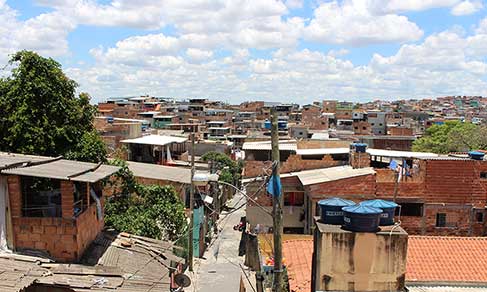Continuous PNAD
Unemployment rate drops to 7.8% in 2023, lowest figure since 2014
January 31, 2024 09h00 AM | Last Updated: February 07, 2024 12h01 AM

The unemployment rate reached 7.4% in the quarter ended December 2023, a drop of 0.3 percentage points (p.p) against the quarter July-September. As a result, the average moving rate of the index went from 7.8% in 2023, which mean a decrease of 1.8 p.p from 2002, when the rate was 9.6%. The data come from the Continuous National Household Sample Survey (Continuous PNAD), released today (31) by the IBGE.
The annual result is the lowest since 2014, and confirms the trend to recovery of the job market observed in 2022 after the impact of the COVID-19 pandemic. That figure is close to the one in the start of the time series, in 2012, when the average was 7.4%. The lowest index in the series was 7.0%, in 2014.
The trend was confirmed by the drop in the average unemployed population from 2022 to 2023: 17.6%, having reached 8.5 million persons. On the other hand, the average employed population once again hit a record in the series and reached 100.7 million persons in 2023, a result 3.8% above 2022. Against the average of 2012 (89.7 million persons), that represents an increase of 12.3%. The average level of employment (percentage of employed persons in the population at working age) also increased and reached 57.6% in 2023, 1.6 p.p more than in 2022 (56.0%).
Number of employees with and without a formal contract reaches a record level in 2023
The annual estimate of the number of workers with a formal employment contract increased by 5.8% in the year, reaching 37.7 million people, the highest figure in the series. The annual number of employees without a formal contract in the private sector showed an increase of 5.9%, reaching 13.4 million people, also the highest result in the series.
The number of domestic workers increased by 6.2%, reaching 6.1 million people. The annual informality rate went from 39.4% to 39.2%, while the estimated discouraged population dropped by 12.4%, reaching 3.7 million people.
Average income rises and wage bill hits a record in 2023
The annual average real earnings was estimated at R$ 2,979, representing a 7.2% increase (or R$199) compared to 2022. This result approaches the highest level in the series, recorded in 2014 (R$ 2,989). The annual real usual wage bill reached R$ 295.6 billion, the highest in the series, with an 11.7% increase (an additional R$ 30.9 billion) compared to 2022.
It is worth highlighting that from this release on, the indicators from the Annual Retrospective Labor Market Survey of Continuous PNAD will be calculated using the annual database per survey visit, including a reevaluation of the time series of such indicators. The annual reference database is the cumulative first visits, except for 2020-2022, which used the cumulative fifth visits due to the Covid-19 pandemic and the resulting decline in response rates for the first visits during that period. Indicator values are available on SIDRA under Annual Continuous PNAD - Labor Market.
Unemployment drops and formal employment hits a record high in the fourth quarter of 2023
Considering only the index for the October to December 2023 quarter, today's released Continuous PNAD shows that the unemployment rate (7.4%) decreased by 0.3 percentage points compared to the July to September quarter (7.7%) and by 0.5 percentage points compared to the same quarter in 2022 (7.9%). It was the lowest rate since the quarter ending in January 2015 and the lowest for a quarter ending in December since 2014.
“The decrease of the unemployment rate was primarily due to a significant expansion of the employed population, meaning an increase in the number of people working, reaching a record in the series that began in 2012," explains Adriana Beringuy, IBGE´s Coordinator of Household Sample Surveys. The employed population reached 101.0 million, showing a growth of 1.1% (an additional 1.1 million people) compared to the previous quarter and 1.6% (an additional 1.6 million) on a year-on-year basis.
“Furthermore, there is a notable increase in the number of formal labor contracts, reaching its highest level in the series," adds Adriana. The number of employees with formal labor contracts in the private sector (excluding domestic workers) increased by 1.6% in the quarter and 3.0% for the year, hitting a peak in the Continuous PNAD series: 37.973 million.
The unemployed population was 8.1 million, with a decrease of 2.8% in the quarter and 5.7% in the year, marking the lowest figure since the quarter ending in March 2015. The compound underutilization rate was 17.3%, down 0.3 percentage points from the quarter ending in September (17.6%) and a recording 1.2 percentage point drop from the same quarter in 2022 (18.5%), reaching the lowest rate since the quarter ending in June 2015 (17.3%). The underutilized population was 19.9 million, the smallest since the quarter ending in January 2016. The informality rate was 39.1%.
In December, there was an expansion in employment in various activity groups
The survey also shows a widespread increase, compared to the previous quarter, in the number of employed persons in various activity groups. “There was expansion in various segments. In the latest results, we noticed a more concentrated movement in the service sector. For this quarter ending in December, industry and construction also contributed significantly,” says Ms. Beringuy.
Compared to the quarter ending in September, the Industrial sector increased by 2.5% (or 322 thousand more people), while Construction expanded by 2.7% (an additional 198 thousand). The group of Transportation, storage and mailing increased by 4.3% (adding 237 thousand people), and Other services grew by 5.8% (adding 302 thousand), while Domestic services increased by 3.9% (adding 228 thousand). Only the Agriculture, livestock, forestry, fishery and aquaculture group saw a reduction in comparison, by 4.8% (a decrease of 403 thousand people).
The average real earnings was R$ 3,032, showing no significant change in the quarterly comparison and a 3.1% increase for the year. The real usual wage bill was R$ 301.6 billion, reaching a new record in the historical series, growing by 2.1% compared to the previous quarter and 5.0% annually.
More about the survey
The Continuous PNAD is the main instrument to monitor workforce in Brazil. The survey sample per quarter corresponds to 211 thousand households surveyed in Brazil. Nearly two thousand interviewers work in the survey in 26 states and in the Federal District, integrated to the data collection network of more than 500 IBGE branches.
The Continuous PNAD is the main instrument to monitor workforce in Brazil. The survey sample per quarter corresponds to 211 thousand households surveyed in Brazil. Nearly two thousand interviewers work in the survey in 26 states and in the Federal District, integrated to the data collection network of more than 500 IBGE branches.
Due to the Covid-19 pandemic, the IBGE implemented data collection by telephone on March 17, 2020. In July 2021, face-to-face data collection was resumed. The identity of the interviewers can be confirmed at the Answering the IBGE website or through the Call Center (0800 721 8181), and their ID numbers can be requested by the informants. See PNAD data on Sidra. The next release of the Monthly Continuous PNAD, related to the quarter ended in December, will be on February 29.




















